As we trekked the winding dirt path from Hồ Thầu Commune toward Bản Luốc, we were surrounded by the immense views of the terraced fields in Hoàng Su Phì District, Hà Giang Province.
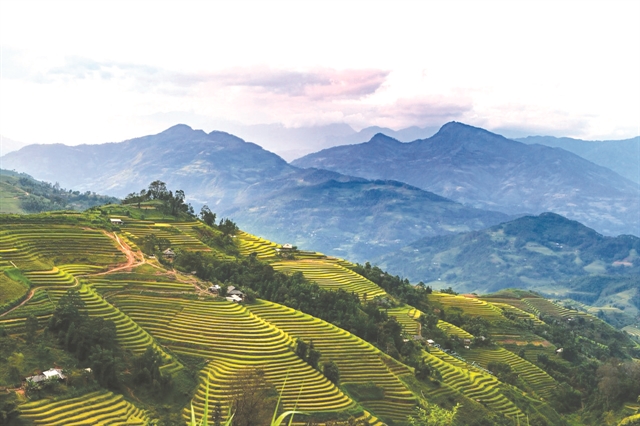
Rice terraces on steep mountain slopes have been the prime source of food for local people for centuries. VNS Photo Đinh Quốc Khánh
Each hill was covered in lush greenery, bearing enough water to plant rice for the people of this land. It’s an amazing view of how people can make miracles out of their daily workload.
The quick shower stopped before we started our trekking tour and the sky could not have been bluer along the road. Stepping on the slippery path, when we look up, a wonderful view meets our eyes. The sa mộc, evergreen pine trees, are dotted along the way, like a scene from an Alpine postcard.
It reminds me of the little girl Heidi and her life with her grandfather. I would read the Vietnamese translation, titled Friendship, when I put my kids to bed. Written in 1881 by Johanna Spyri, Heidi has become the most well-known work of Swiss literature.
Indeed, the trekking tour we embarked upon is end-product of a fruitful project funded by Helvetas, the Swiss development organisation, which has used Swiss tax-payer investment to help communities in Việt Nam since 1994. Carried out by CRED – the Center for Rural Economy Development – based in Hà Nội, the project, titled "Improving Livelihoods of Ethnic Communities through Community-based Tourism", had terminated in a joyful reunion of local home-owners, tour operators, and last but not least, local officials, whose jobs were to provide local people with tools and create mechanisms to improve people's lives.
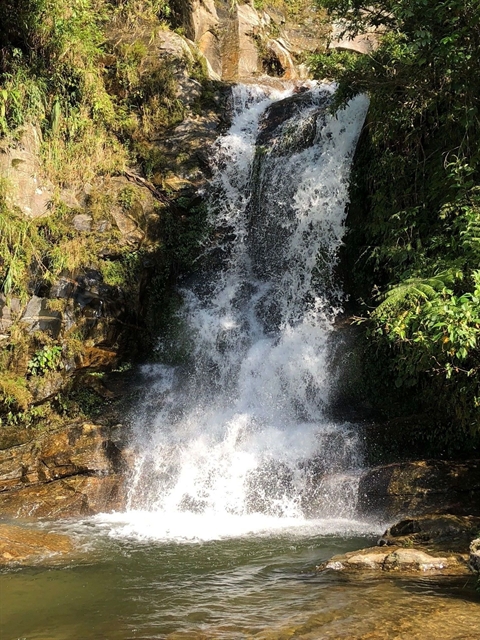
COOLING DOWN: The waterfall makes a perfect refreshing moment on a three-hour trek. VNS Photo Mỹ Hà
In a simple ceremony at Hoàng Su Phì District hall, CRED director Nguyễn Lam Giang said, "I would personally like to thank Mr Lù Văn Chung, the then vice president of Hoàng Su Phì's People's Committee, for reaching out to us five years ago. He and his entourage from Hoàng Su Phì went to our office in Hà Nội and requested a project for community-based tourism."
Community-based tourism
Many trips and exchanges were carried out until they worked out what was best for people of the district, who live among the most picturesque terraced rice fields, yet have to work hard and still live in poverty.
Over the course of five years, VNĐ15 billion (US$650,000) has been spent on the project, including VNĐ2 billion ($86,000) loaned at low interest rates within the community.
In Hà Giang's Hoàng Su Phì District, five communes of Thông Nguyên, Nam Sơn, Hồ Thầu, Bản Luốc and Bản Phùng have benefitted from the project loans.
Three other communes in Cao Bằng Province including Phia Thắp in Quảng Uyên, Lũng Niếc and Khuổi Ki in picturesque Trùng Khánh District also benefitted from the project.
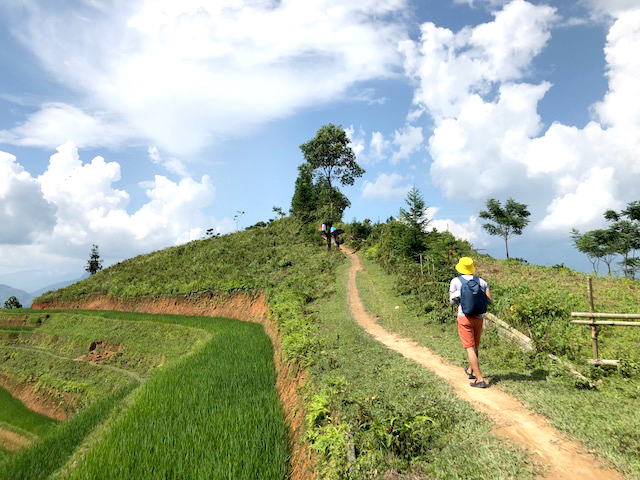
ON THE ROAD: A traveller takes the 3-hour walk from Suối Thầu to Bản Luốc Commune, one of the most beautiful trekking paths in Hoàng Su Phì. VNS Photo Mỹ Hà
The project has three major components of creating new tourism products and raising the capacities of local home-owners, connecting to the larger market and improving accompanying policy.
Gradually, local communities have improved their awareness of community-based tourism. Small groups on CBT were set up for mutual assistance and a CBT fund was established, as well as peer visits and workshops.
The project has set up 28 homestays in two provinces, trained locals on safety for visitors, nutrition and home-cooking, and how to run a home-stay. This introduces homeowners to the needs of visitors.
In 2018, the provinces welcomed 28,600 visitors, of which 9,000 were from abroad. This is up from only 13,800 people in 2015, of which 2,900 were international.
The first six months of 2019 saw a growing number of 18,000 visitors.
During the project, 500 homestay-related jobs were created and more than 1,000 people benefitted from charity activities generated by the project. Total turnover of VNĐ6.5 billion from 2016-2018 was recorded, not including the sales from local products.
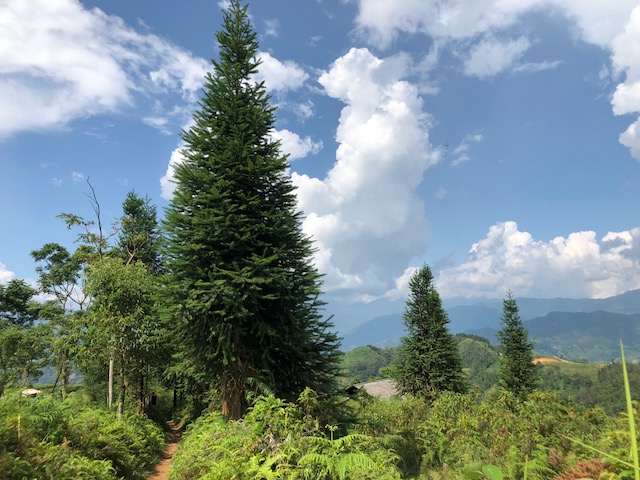
ALPINE: Located in the subtropical region, the mountains of Hoàng Su Phì are home to sa mộc, a treasured hard-wood sycamore tree. VNS Photo Mỹ Hà
At the end of the project, an assessment by independent consultants rated its success as 4.5 out of 5. The most successful home-owner who came out of the project with the most impressive success story was Triệu Mềnh Kinh.
"I'm very happy to let you know that three years ago, I was the only one who opened my house as a homestay for tourists. Now we have four homestays in our hamlet and by the end of this year, two more will be added to the list," Kinh said about the homestay model that worked for him in Nậm Hồng Commune of Hoàng Su Phì.
In Kinh's case, he was born with an entrepreneurial mindset and reached out of his community for new skills and expertise before he met with the project co-ordinators.
"I used to have people staying at my home," Kinh said, standing in his brother's house, which also became a homestay overlooking the iconic rice paddies. "The porters used to look for places to stay for trekkers and they would stay a night at our home then leave."
Kinh said he spent six months in Sa Pa (Lào Cai Province) learning how to cook before working in manual jobs to find a foothold in the hospitality business.
When the project was implemented in his hamlet, Kinh was sent to Mai Châu (Hoà Bình Province) to learn from an established homestay there. He gained skills to run a homestay, opening his own home to tourists.
He was able to borrow VNĐ80 million ($3,400) from the project and has paid half back so far. The first year he built his stilt house, he hosted 40 visitors. The second year, the number went up to 100, and this year, he expects to host up to 200 visitors.
Clean water for rice
Kinh's successful model spread to Quyên – his younger brother – and two more households in the commune, who invested in facilities to host up to a dozen visitors overnight.
Kinh now owns two homestay facilities which can host 22 visitors at one time. To serve visitors who wish to have some privacy, Kinh even built separate bungalows with 24 beds, still with a great view of the fields, of course.
Aware of the potential for waste, home-owners have trash burners on the premise and the ability to collect water. "I have the water collected in a pond, which runs over to a piece of land, where I plant taro before it gets channelled to the spring," Kinh said.'
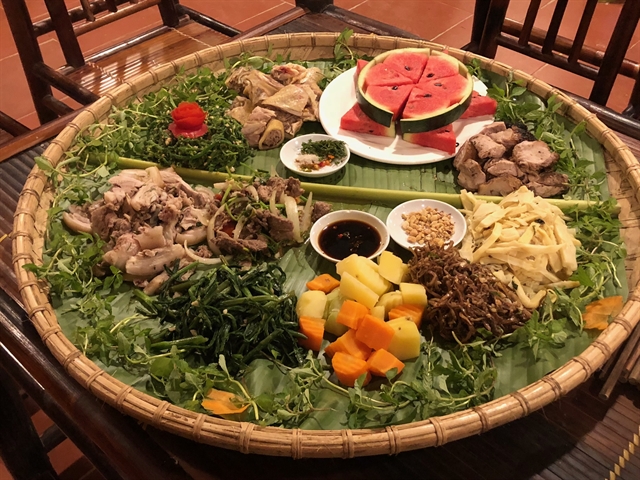
MOUNTAIN MEAL: Balanced food tray of assorted meat and vegetables. VNS Photo Mỹ Hà
Drinking culture
When you're in the mountains, do as the mountaineers do – rice wine or maize vodka for lunch and dinner. It is deemed disrespectful to turn down a drink when you’re a guest at someone’s house.
From the homeowners perspective, they used to drink at parties or at the market on Sunday. Now they have to make a toast to visitors every meal, having a bad effect on their health.
On this trip, I met Triệu Mùi Mủi, a Red Dao woman who three years ago told me that she had to step in to toast with visitors because her husband's stomach was so sick he couldn't take in any more alcohol. "Now he's fine," she said.
Making a toast was so deeply rooted in the culture, almost every member of the hosting board toured the room to offer a drink, shaking hands for another round, so the ritual goes.
The women of the table had to excuse ourselves for only sipping a few drops and we were forgiven, but not the men. A western man in our group, who had been declining offers to drink for three days (five meals altogether) saying he had to fast before a meditation trip, at the request of a local lady decided to ignore all he had said before.
"Cheers," he said, and the rest of us went wild cheering!
If he had been trying to attain nirvana, there's only one more step to reach enlightenment, then he dropped out!
Nguyễn Mỹ Hà